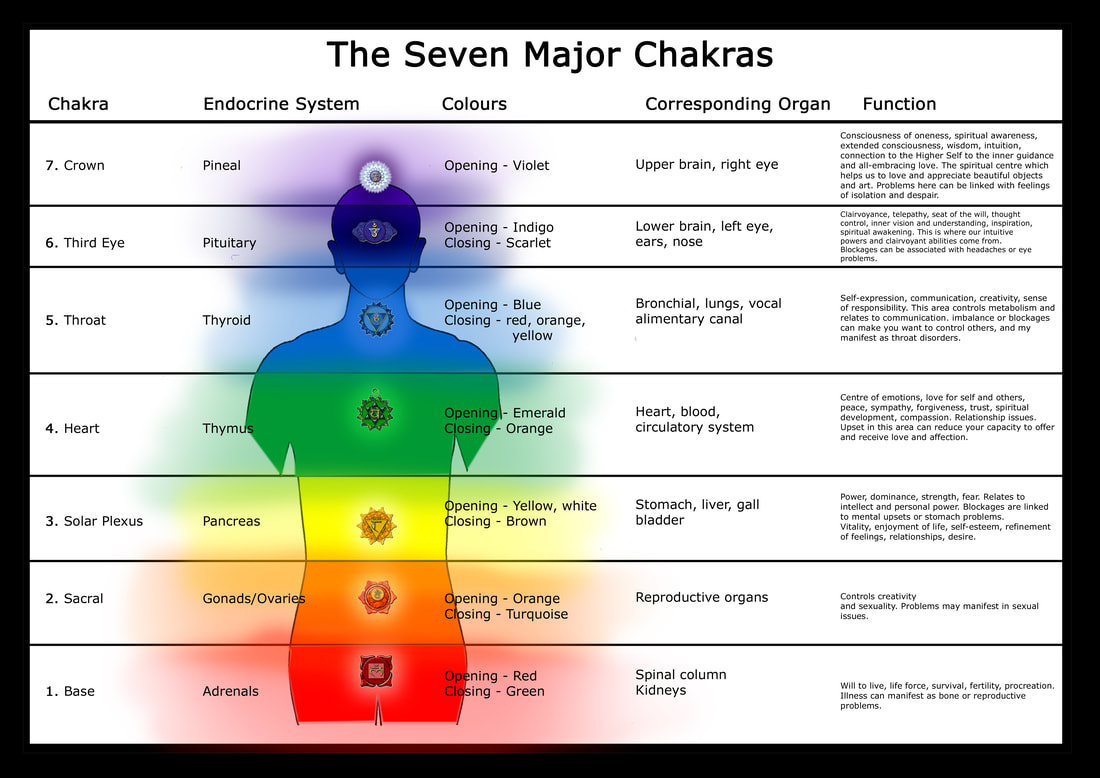 The Chakra System Part 1 Throughout history, the idea of a universal energy percieved throughout all of nature has been held by mystics, religious practices and more recently Western Scientists. Think od the Indian spiritual tradition of prana; the Chinese calling vital energy Chi: the Jewish Kabala referring to astral light and the Christian religious paintings indicating a field of light or halo surrounding Jesus and other religious figures. As I mentioned in my last blog, human beings can be viewed as networks of complex energy fields that interact with physical and cellular systems. The physical system resonates at a particular vibration and is an integral part vibrating at a lower frequency with the higher energy systems surrounding it. These higher energy systems referred to as our subtle bodies are composed of matter with quite different frequency characteristics than those of the physical bodies. These systems are physically superimposed on one another in the same space and together they play vital parts in the total functioning of the human being. Various writings from the Indian Yogic teachings refer to special energy systems which exist within these subtle bodies. They are known as Chakras The word Chakra comes from the Sanskrit meaning 'wheels or disks', and they resemble whirling vortices of subtle energies. These energy systems are associated with accessing universal energy and transmuting it into a useable form within the human structure. The origin of the seven fold chakra system that is most commonly followed today, has its roots in the Hindu culture. The earliest mention of the term chakra is said to come from the Vedas, the four holy books of the Hindus, believed to date back before 2500 BC. However, the notion of seven “maps of consciousness” for optimum well-being goes back much further. Physiologically, the chakras are involved in the flow of higher energies via subtle energetic channels to the cellular structure of the physical body. Therefore, the chakra systems seem to function as energy transformers, stepping down energy from a higher frequency to a lower level of energy. This energy is then translated into the hormonal and physiological system to bring about cellular changes throughout the body. Although the human energy system is said to have many chakras, and new ones are being discovered all the time, the traditional Hindu system names the seven major ones previously mentioned. The location of the seven chakras associated with the physical body corresponds with the major nerve networks. Each major chakra on the front of the body is paired with its corresponding one on the back of the body. Together they form the front and rear aspects of a chakra. There are also believed to be at least twenty-one minor chakras. Energetically, the chakras are openings that allow energy to flow into and out of the aura. As this energy is associated with a form of consciousness, the energy exchange is experienced in terms of seeing, hearing, feeling, sensing, intuiting or direct knowing. The tips of the chakras where they are connected to the Universal Energy Field (UEF) are referred to as the heart or root of the chakra. Within the heart of the chakra are seals which control exchange of energy between the layers of the auric field (subtle bodies). To allow certain energy to flow from one layer to another through the chakra, it must pass through the seals in the heart of the chakra. This is most probably why the Yogic literature uses the flower analogy - a lotus flower opening and shutting to explain the chakra. Even when we are perfectly still – as in a static yoga pose or sitting in silence doing nothing more than breathing, - the chakras are doing a dynamic dance. They are opening, closing, shifting, spinning, expanding and contracting. The energy generated by the Chakras moves up and down the spine. When flowing freely, that energy can connect us with the Earth at the same time that it connects us with the Higher Realms of existence. The energy has the power to lift us out of fatigue, depression, illness and despair. It has the ability to bring body, mind and soul together as one. It is therefore important to open the chakras and increase the flow of energy, the more energy flows through the system the healthier the human system will be. A brief look at the individual Chakras The first chakra, Muladhara (Root Chakra) is situated near the coccyx and is associated with the adrenals, triangular shaped glands that cap each of the kidneys. These glands secrete a variety of hormones including those that regulate the body’s metabolism. These glands also produce adrenalin, the hormone essential for our fight or flight response. The Root Chakra is associated with survival. The second chakra, Svadisthana (Sacral Chakra) originates near the tip of the coccyx or sacrum. It is associated with the male and female reproductive organs or gonads. Our relationship with our own sexuality and issues of emotional balance concerning that is a key association of this chakra. The third chakra, Manipura, (Solar Plexus Chakra) lies in the upper middle abdomen below the tip of the sternum. It is associated with the pancreas which lies behind the stomach and secretes a variety of substances essential for the effective digestion of food. The fourth chakra, Anahata, (Heart Chakra) can be found in the mid sternal region directly over the heart and is associated with the thymus gland. The thymus produces hormones that stimulate general growth, particularly in early life. The fifth chakra, Vishudda, (Throat Chakra) is situated in the neck near the Adam's apple, directly over the thyroid gland. It has associations with both the thyroid and parathyroid glands. The thyroid manufactures thyroxine, which controls the body’s metabolic rate, and the parathyroid gland controls the level of calcium in the blood stream. The sixth chakra, Anja, (Brow or Third Eye Chakra) in the mid-forehead above the bridge of the nose is situated over the pituitary gland. This vital gland influences growth, metabolism, and general body chemistry. The seventh chakra, Sahasrara, (Crown Chakra) is located on top of the head over the pingland which produces melatonin, a hormone that affects the modulation of wake/sleep patterns and photoperiodic (seasonal) functions.
2 Comments
Fred Fortman
27/9/2021 10:46:59 pm
You are able to explain the Chakras for me in a very clear and understandable manner. thank you
Reply
Leave a Reply. |
AuthorI'm Jane Marin, artist, illustrator, writer, self confessed eclectic bohemian. Follow me and my musings right here on my blog. Titles
All
Archives
August 2021
|
Proudly powered by Weebly


 RSS Feed
RSS Feed